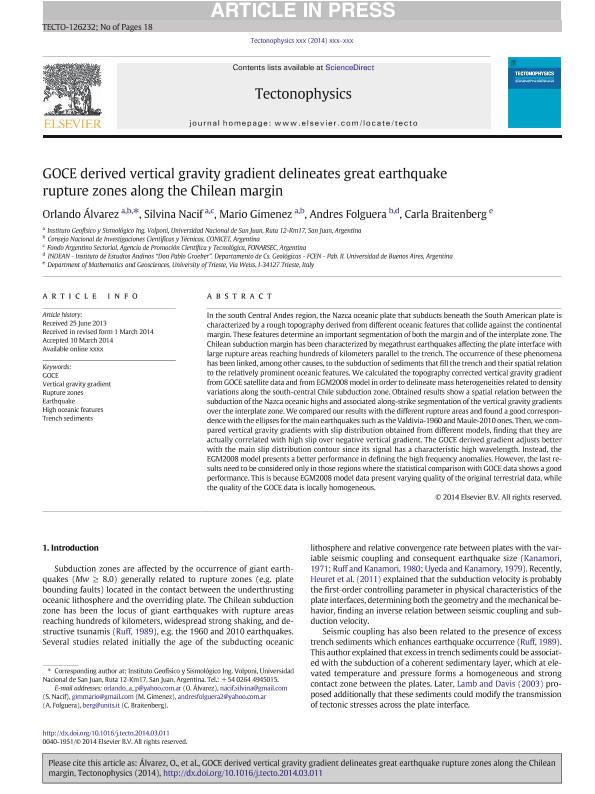Artículo
GOCE derived vertical gravity gradient delineates great earthquake rupture zones along the Chilean margin
Alvarez Pontoriero, Orlando ; Nacif Suvire, Silvina Valeria
; Nacif Suvire, Silvina Valeria ; Gimenez, Mario Ernesto
; Gimenez, Mario Ernesto ; Folguera Telichevsky, Andres
; Folguera Telichevsky, Andres ; Braitenberg, Carla
; Braitenberg, Carla
 ; Nacif Suvire, Silvina Valeria
; Nacif Suvire, Silvina Valeria ; Gimenez, Mario Ernesto
; Gimenez, Mario Ernesto ; Folguera Telichevsky, Andres
; Folguera Telichevsky, Andres ; Braitenberg, Carla
; Braitenberg, Carla
Fecha de publicación:
03/2014
Editorial:
Elsevier
Revista:
Tectonophysics
ISSN:
0040-1951
Idioma:
Inglés
Tipo de recurso:
Artículo publicado
Clasificación temática:
Resumen
In the south Central Andes region, the Nazca oceanic plate that subducts beneath the South American plate is characterized by a rough topography derived from different oceanic features that collide against the continental margin. These features determine an important segmentation of both the margin and of the interplate zone. The Chilean subduction margin has been characterized by megathrust earthquakes affecting the plate interface with large rupture areas reaching hundreds of kilometers parallel to the trench. The occurrence of these phenomena has been linked, among other causes, to the subduction of sediments that fill the trench and their spatial relation to the relatively prominent oceanic features. We calculated the topography corrected vertical gravity gradient from GOCE satellite data and fromEGM2008 model in order to delineate mass heterogeneities related to density variations along the south-central Chile subduction zone. Obtained results show a spatial relation between the subduction of the Nazca oceanic highs and associated along-strike segmentation of the vertical gravity gradients over the interplate zone.We compared our results with the different rupture areas and found a good correspondence with the ellipses for the main earthquakes such as the Valdivia-1960 andMaule-2010 ones. Then, we compared vertical gravity gradients with slip distribution obtained from different models, finding that they are actually correlated with high slip over negative vertical gradient. The GOCE derived gradient adjusts better with the main slip distribution contour since its signal has a characteristic high wavelength. Instead, the EGM2008 model presents a better performance in defining the high frequency anomalies. However, the last results need to be considered only in those regions where the statistical comparison with GOCE data shows a good performance. This is because EGM2008 model data present varying quality of the original terrestrial data, while the quality of the GOCE data is locally homogeneous.
Palabras clave:
Rupture
,
Zones
,
Satelital
,
Gravimetry
Archivos asociados
Licencia
Identificadores
Colecciones
Articulos(IDEAN)
Articulos de INSTITUTO DE ESTUDIOS ANDINOS "DON PABLO GROEBER"
Articulos de INSTITUTO DE ESTUDIOS ANDINOS "DON PABLO GROEBER"
Articulos(SEDE CENTRAL)
Articulos de SEDE CENTRAL
Articulos de SEDE CENTRAL
Citación
Alvarez Pontoriero, Orlando; Nacif Suvire, Silvina Valeria; Gimenez, Mario Ernesto; Folguera Telichevsky, Andres; Braitenberg, Carla; GOCE derived vertical gravity gradient delineates great earthquake rupture zones along the Chilean margin; Elsevier; Tectonophysics; 622; 3-2014; 198-215
Compartir
Altmétricas



